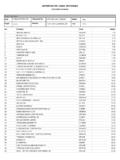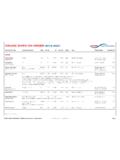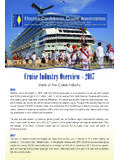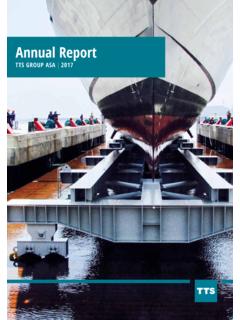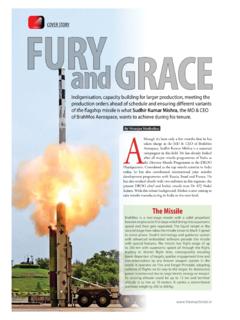Transcription of V. 4-2-2015 ADVISORY TO SHIPPING No. A-34-2017
1 AUTORIDAD DEL CANAL DE PANAM . EXECUTIVE VICE PRESIDENCY FOR OPERATIONS. 3654-A (OPXI). V. 4-2-2015 . ADVISORY TO SHIPPING No. A-34-2017 . September 22, 2017. TO : All SHIPPING Agents, Owners, and Operators SUBJECT: Applicable Pricing Structure by Definition of Vessel Types Ship types are assigned to vessels on their first Canal transit based on criteria that considers both original design and cargo carried. The criteria are based on the Regulation for the Admeasurement of Vessels to assess Tolls for use of the Panama Canal and are consistent with international standards and conventions.
2 The ACP's Admeasurement Unit is responsible for assigning ship types according to the information provided by the customer. The Panama Canal Authority (ACP) established a market segmentation structure in 2002. based on ship types and cargo characteristics, and introduced a pricing system in 2005. based on TEUs for container vessels and other vessels with container-carrying capabilities. In May of 2007, the ACP implemented toll differentiation based on market segments. In October 2012, in order to strengthen and customize the value of the route, the tanker segment was redefined into three more specific segments: tankers, gas carriers and chemicals tankers.
3 In addition, the vehicle carrier segment was redefined whereby the Roll On/Roll Off vessels were incorporated into this segment. The LNG segment was established In April 2015, but was implemented in April 2016, to incorporate gas carrier vessels transporting liquefied natural gas. Effective October 1, 2017, Container/Breakbulk vessels from the segment others will be reassigned to the general cargo segment. Ship Type Code: Ship Type MARKET SEGMENT SHIP TYPES. Code General Cargo 01. General Cargo Container/Breakbulk Ship 06. Refrigerated Cargo Refrigerated Cargo 02. Dry bulk carrier 03.
4 Dry Bulk Carriers Vehicle/Dry Bulk Carrier 10. Woodship Carrier 27. Crude/Product Tankers Crude/Product Tanker 28. Chemical Tankers Chemical Tanker 29. Liquefied Petroleum Gas Carrier LPG Carrier 12. LNG Carrier (Moss) 30. Liquefied Natural Gas carrier LNG Carrier (Membrane) 31. LNG Carrier (Other) 32. ADVISORIES ARE AVAILABLE AT FOR ETAS OR DIRECT COMMUNICATION WITH OUR OFFICES, REFER TO NOTICE N-3-2017. 3654-A (OPXI). V. 4-2-2015 . September 22, 2017. Subject: Applicable Pricing Structure by Definition of Vessel Types Container Vessels Full Container Ship 07. Roll On/Roll Off 08.
5 Vehicle Carriers/RoRo Vehicle Carrier 09. Passengers Passengers Vessel 11. Dry/Liquid Bulk Carrier 05. Barge Carrier 13. Barge, Not Self-Propelled 14. Barge, Self-Propelled 15. Fishing Vessel 16. Factory Ship 17. Tug 18. Research Vessel 19. Others Cable Ship 20. Yacht 21. Rig Tender/Supply Vessel 22. Tank Barge, Not Self-Propelled 23. Tank Barge, Self-Propelled 24. Barge Integrated 25. Tank Barge Integrated 26. Other PC-Net 50. Dredge 90. Floating Drydock 91. Others (pay by Displacement) Warship 93. Submarine 94. Other Displacement 99. General Cargo Segment This segment includes all vessels that transport individual items, such as boxes, pieces of equipment and penalized cargo.
6 This segment is not considered time sensitive. General Cargo (01). A vessel designed to carry break-bulk general or dry cargo. Built to transport individual items such as boxes, pieces of equipment, and penalized cargo. Any and all cargoes are loaded either in drums and bales or on pallets, primarily non-refrigerated. Such cargoes are put in general holds with no specialization. This type of vessel will generally be multi-deck with facilities for loading/discharging cargo. Container/Break Bulk Ship (06). A vessel specially designed to carry containers and/or break bulk cargoes below deck.
7 This type of vessel will typically have full width hatches and boxed holds for the carriage of break bulk cargo and/or containers and many are fitted with gantry cranes. 3654-A (OPXI). V. 4-2-2015 . September 22, 2017. Subject: Applicable Pricing Structure by Definition of Vessel Types Refrigerated Cargo Segment This segment requires timely transit but carries less valuable cargo. It includes specialized vessels known as reefers that generally transport perishable cargo. Refrigerated Cargo Carrying Vessels ( Reefers ) (02). A multi deck cargo vessel whose cargo spaces are predominantly designed for the transport of refrigerated cargo such as fruit, meat, and other food products across the sea at various temperatures.
8 Includes cargo vessels with 80% or more insulated cargo space. Dry Bulk Carriers Segment This segment is largely price-driven due the relatively large volume and low value of the cargo transported. This segment category includes vessels known as bulk carriers. The main commodities transported in dry bulkers are grains and other agricultural commodities, minerals, metals and ores, coal and coke, fertilizers and lumber products. This segment includes Dry bulk carriers, Vehicle/Dry Bulk Carriers and Woodchip carriers. Dry Bulk Carrier (03). A vessel designed to carry dry cargo in bulk such as coal, iron ore, grain, scrap metal, etc.
9 This type of vessel is normally single deck with topside tanks capable of carrying a variety of self-trimming cargo. Vehicle/Dry Bulk Carrier (10). A bulk carrier with movable decks for additional carriage of vehicles. The vessels use the container ship principle to stow platforms loaded with cars into cellular holds. These platforms can also carry other cargoes such as lumber. Woodchip Carrier (27). A single deck cargo vessel designed for the carriage of wood chips. Crude/Product Tanker (28). A tanker for the bulk carriage of crude oil and also refined oil products. Chemical tanker (29).
10 A tanker for the carriage of chemical cargo, lube oils, vegetable/animal oils and other chemicals as defined in the International Bulk Chemical Code. Liquefied Petroleum Gas Carrier (12). A tanker for the bulk carriage of Liquefied Petroleum Gas in insulated tanks, which may be independent or integral. The cargo is pressurized (smaller vessels), refrigerated (larger vessels) or both (semi-pressurized) to achieve liquefaction. The most common cargoes are ammonia, propane and butane. Liquefied Natural Gas Carrier: A tanker for the bulk carriage of Liquefied Natural Gas (primarily methane) in independent insulated tanks.


